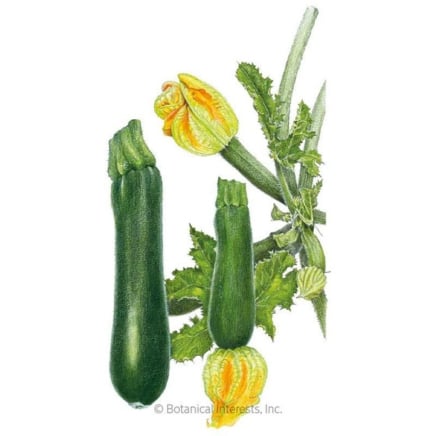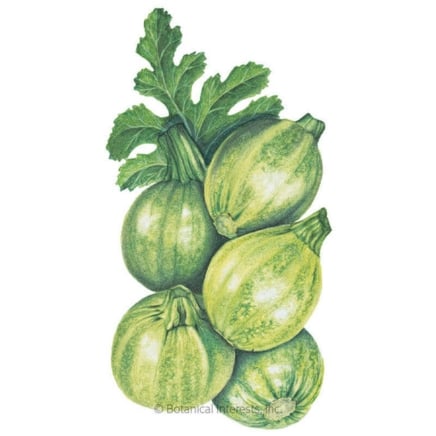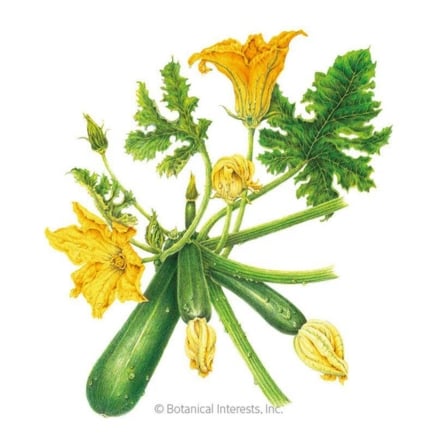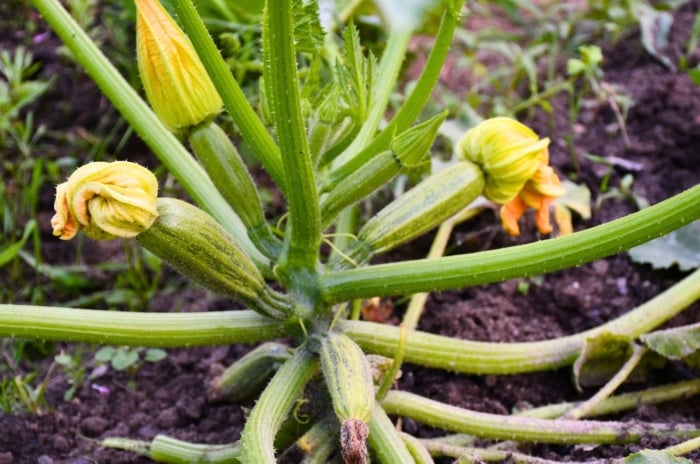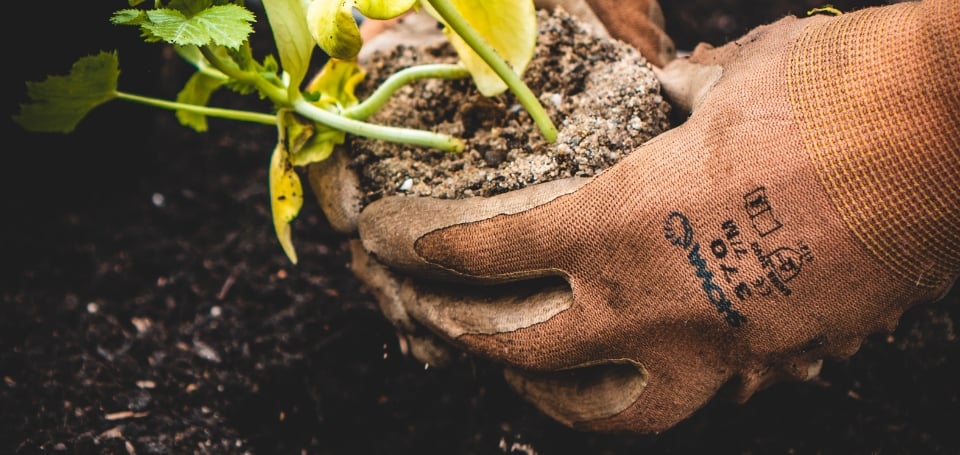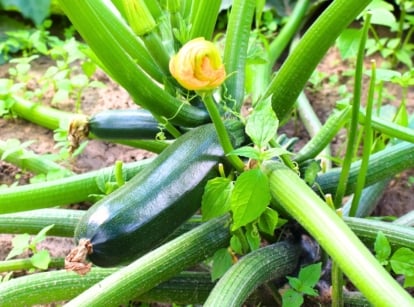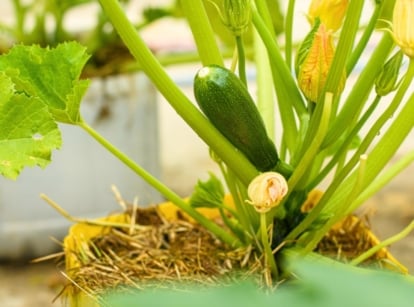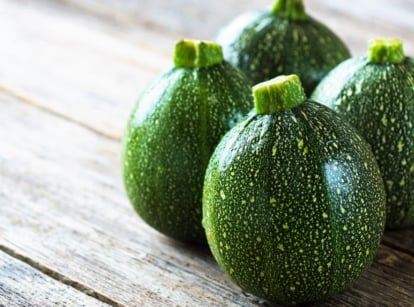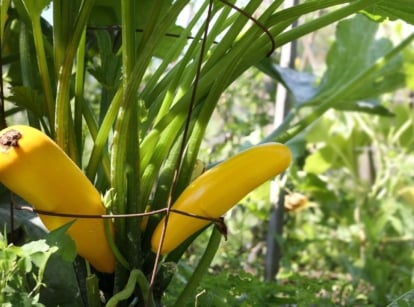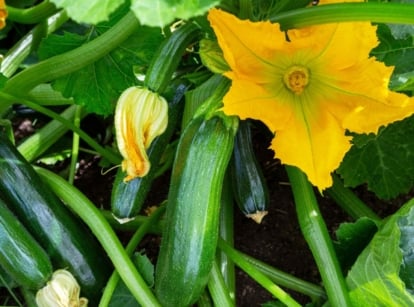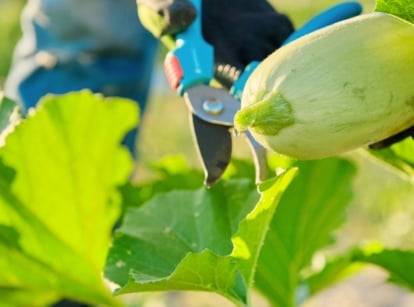When to Harvest Zucchini for Best Flavor
Zucchini, the prolific summertime producer, grows before our eyes. Knowing when to harvest all those fruits brings peak flavor and texture. Join gardening expert Katherine Rowe to learn when to pick zucchini and the tender blossoms, too.

Contents
Zucchini is a quick-developing crop with glossy, deep green fruits and varieties in white, yellow, and striped. The heat-loving fruits are easy to incorporate from stem to table in summer dishes and, with prolific yields, to store for future winter soups and breads.
Because they develop before our eyes, checking every day or two once the fruit sets helps us pick at the right time. Zucchini is tender and tasty throughout its development until it reaches the tipping point of too big, too dense, and too seedy.
Here, we’ll outline everything you need to figure out when to harvest your zucchini, including what to look for in the perfect pick, how to determine readiness, and ways to preserve the bounty. Picking zucchini for the best flavor is one of the easiest and most rewarding tasks of the season.
Zucchini Basics

Zucchini is a summer squash that thrives in warm temperatures. The bushy vines take off in early summer to bloom and produce lots of glossy fruits before frost. The vines are easy to grow and, depending on the variety, make good compact selections for containers, raised beds, and growing vertically.
Zucchini belongs to the Cucurbitaceae family with cucumbers, melons, and winter squashes. These favorite crops share and transmit the same pests and diseases, so it’s best to separate the group when feasible. Crop rotation is also beneficial for the species.
Incorporate nectar and pollen-rich plants and companions to promote beneficial insects and boost pollination. If you live in an area plagued by squash vine borer, consider growing resistant winter squashes like Cucurbita moschata. While they mature in the winter, they’re a great stand-in for summer squash with harvesting immature fruits early.
Cucurbits need numerous repeat bee visits for adequate pollen transfer from male to female flowers. Without sufficient pollination, fruits may be misshapen or lacking in number. If bee activity is low at the time of flowering, you can try hand-pollinating, playing the role of the bee to move pollen from the male to female flowers.
Optimal growing conditions include:
- Full sun (six plus hours of sunlight daily)
- Well-draining, sandy loams
- Slightly acidic to neutral soil with a pH near 6.8
- Warm conditions (sow seeds when soil temps reach 65°F (18°C) or higher; 75-85°F (24-29°C) is optimal for germination and growth)
- One to two inches of water per week (rainfall and irrigation)
Timing the Harvest

Zucchini is tasty at various stages of development. Their mature size depends on the variety, but harvesting young fruits yields delicious results.
To gauge readiness, count out the days to maturity from your sowing date. The seed packet lists the number of days to harvest under optimal conditions. The summer squashes have a quick turnaround, usually between 45 and 60 days.
The count offers a guideline on when to expect ripe fruits. Small, round varieties may mature even more quickly.
Knowing When To Harvest Zucchini
Once the fruit sets, it helps to check daily since they form so quickly. Left on the vine, zucchini continues to grow in size. They become large but also less flavorful, tougher, more watery, and with larger seeds than with immature fruits. While the seed cavity increases, the fleshy area decreases.
Follow these indicators to harvest zucchini when it is just the right size with the best flavor.
Size

Size is the primary indicator of zucchini readiness. Harvest them as baby squash at only a few inches long for tenderness and a nutty flavor. Sometimes, the flower remains attached as an added bonus.
On average, the best length to enjoy summer squash is six to eight inches. At this size, the seeds are soft and undeveloped, with more flesh than the seed cavity. Round zucchini is typically most flavorful at three to six inches around.
When the fruits overgrow beyond the tender stage, use them for casseroles, stuffing, and as sweet additions to baked goods. Once beyond about 10 to 12 inches, toss them in the compost pile or feed them to the chickens.
Color

Color, too, is a checkpoint for ripeness. The color at picking should match the variety’s mature tone. The signature dark, shiny green with a creamy white interior is one to look for, depending on the variety.
Firmness

Zucchini that is ready to harvest will also have a good firmness when you give it a light squeeze—not too hard or soft.
Score the skin with a fingernail to test viability. Larger fruits left on the vine will have a thicker rind that resists marking. Ready ones incur a light dent.
Blossoms

Both male and female blossoms are edible and are delicious stuffed, sautéed, or lightly fried. To harvest blossoms, pick male flowers in the morning before they wilt. Male flowers are larger and will have no fruit attached. Leave enough for cross-pollination and fruiting. Female flowers have an immature fruit at their base.
How To Pick

To pick zucchini, cut them from the stem with pruners or a sharp knife. Twisting or pulling can injure the vine, so clipping is the safest method. When cutting, leave a portion of the stem attached to the fruit to prevent damage and decay post-harvest.
Take care with the vines during harvest. Each joint can send out roots for sturdier, more productive vines, and shifting during cutting can disrupt them.
Harvest often to keep the vines healthy and producing. It’s best to avoid clipping the stems in wet weather, as it promotes the spread of disease at the wound point.
Storage

The flavorful zucchinis are ready for fresh eating right off the stem. They store for several days in the refrigerator before becoming soft, pitted, or mushy. Or, plan to freeze or can them for future enjoyment. Pickling yields delicious quick pickles, relishes, and chutneys.
To freeze zucchini, rinse and dry the harvest. Slice, cube, or grate them. You can freeze them raw or opt to blanch them first. To blanch, place the pieces in boiling water or a steamer basket for three minutes (one to two minutes for shredded pieces). For cubes and slices, transfer them to a cold water bath for the same length of time. Allow them to drain and dry before transferring to an airtight container or freezer bag to freeze the lot.
Popular Varieties
There are many delicious summer squash varieties. Most zucchini are bush types, but some have long vines, so choosing the right size and selection for growing space is key. Save space with pots and vertical growth on stakes and trellises.
‘Black Beauty’

|
|
botanical name Cucurbita pepo ‘Black Beauty’ |
|---|---|
|
|
sun requirements Full sun |
|
|
height 2′ |
‘Black Beauty’ is a favorite introduction from the 1920s with a high yield of dark, greenish-black fruits that have thin skins and tender, buttery interiors. The All-America Selections award winner bears prolific, early, and flavorful fruits on easy-to-grow vines.
‘Black Beauty’ is ready to harvest 50 to 55 days after sowing. Clip them while young for the best texture and flavor.
‘Emerald Delight’

|
|
botanical name Cucurbita pepo ‘Emerald Delight’ |
|---|---|
|
|
sun requirements Full sun |
|
|
height 2′ |
‘Emerald Delight’ is a compact hybrid with full-sized fruits. The highly productive, bush types yield a bounty of tender zukes. Vines grow three to four feet wide with an open form.
Harvest the dark green fruits at their peak of six to eight inches long, when the skin is smooth and shiny, and the interior is creamy. The airy habit makes the ready fruits easy to see and pick. Vines resist powdery mildew and mosaic viruses, common diseases among the cucurbits.
‘Emerald Delight’ is ready in 50-55 days and optimal for areas with short growing seasons or for sowing a later-season successional round.
‘Round Zucchini’

|
|
botanical name Cucurbita pepo ‘Round Zucchini’ |
|---|---|
|
|
sun requirements Full sun |
|
|
height 24″ |
These novel petite rounds have a sweet flavor and make their own ready-made, personal-sized serving bowls. ‘Round Zucchini’ produces three to four-inch smooth, shiny globes. The yellow-green fruits have dark green mottling, and leaves have silver flecks.
‘Round Zucchini’ is fast-developing and ready to begin harvesting at 45 days from sowing. At only three feet wide, the compact, bushy selection is ideal for growing in the ground or in containers.
Frequently Asked Questions
What happens if I don’t harvest zucchini?
Harvesting zucchini regularly promotes healthy vines and continued production, as energy goes into flowering and fruits that remain on the stem. Zucchini left on the vine grows large to fully develop their seeds until they begin to break down and decay. If a little oversized, use them for baking and stuffing. Clip off extra-large fruits and compost them or feed them to chickens and livestock. Toss those with any spoilage to avoid spreading potential diseases among the cucurbits.
Can I sow more than one round of zucchini seeds per season?
Zucchini is a great crop for successional planting. Since they grow quickly, it generally only takes a couple of months to enjoy the yield. Direct sow seeds in July or early August, or up until a couple of months before your first anticipated frost date in the fall. Summer squash is frost-sensitive and won’t tolerate chilly conditions. An advantage of a late planting is that it misses the peak activity of certain pests like squash vine borer.

